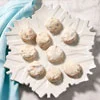Whether you are investing in your very first Dutch Oven or looking to expand your collection, the question about whether to choose a round or oval Dutch Oven is hotly contested, even here at Le Creuset. There are those that are squarely on team Round, arguing in favor of this classically shaped cooking vessel. But there are also those rooting for team Oval, noting that it is both a prettier and more practical design.
Regardless of which team you are on, though, both round and oval Dutch Ovens are extremely versatile for a wide variety of recipes. Below are a few questions to answer to decide whether a round or oval Dutch Oven is best for your style of cooking.
Shop Dutch OvensWhich One is Right for You?
Many people find that having both a round and oval Dutch Oven in their kitchen arsenal allows them to best match the pot to the recipe. There are certainly advantages to each shape, though, especially as it relates to what you like to cook as well as how much space you have in your kitchen.
What Do You Like to Cook?
Do you tend to gravitate more toward simmering and braising on the stove or do you like to crank up the oven for baking and roasting projects? Generally speaking, round pots tend to fit better on the stovetop because the shape is consistent with the shape of the burner. On the other hand, an oval shape really shines in the oven.
If you like to cook longer cuts of meat and large roasts, say a pork loin or whole beef tenderloin, then you might prefer an Oval Dutch Oven. The oval shape also better accommodates whole chickens, ducks and turkeys better. The pot naturally mirrors the shape of these cuts, and allows plenty of room for air to circulate around the meat for even cooking and crispy golden brown exteriors.
Also, if you bake bread at home you might find that you prefer the oval shape over the round as well. Bread will conform to the shape of the pot it is baked in, especially with wet doughs like the ‘no knead’ variety. So with an Oval Dutch Oven, your bread will bake in a more traditional loaf shape versus a rounded boule shape that results from a Round Dutch Oven.
Note that when cooking on a stovetop, heating an oval pot over a round burner will take longer. Some newer gas and electric stoves now offer a central oval burner, or two burners that can be joined to create an oval burner which addresses this issue. But even if you don’t have an oval burner, our enameled cast iron is superior at heat distribution and retention. So once the pot is preheated, both the oval and round Dutch Ovens will perform equally well at browning and searing on the stovetop.

"In a perfect world, I’d say one round, one oval."
How Much Room Do You Have?
Another important question to ask is how much room do you have in your kitchen? If you have a small or tightly configured stovetop, round ovens will take up less space allowing more room for other pots and pans at the same time.
Oval shapes can be a bit harder to fit into a cabinet as well, and are not as easy to stack for storage. So if you are challenged for space, you might prefer a round shape. Although, some do argue that the oval is a prettier shaped design and want to proudly display it versus tucking it away in a cabinet.
One last consideration is that the shape distribution between round and oval Dutch Ovens will vary slightly as a result of the different profiles. For similar quart capacities, round ovens will tend to have deeper sides while oval shapes will be wider and shallower. So you might want to take this into consideration when choosing the shape, but also when choosing the size.


Best-selling Dutch Oven Shape
Still unsure what shape Dutch Oven is right for you? Bottom line is that there is really no wrong answer to this question. Both round and oval Dutch Ovens are multipurpose, durable and well suited for any recipe. We offer both shapes in a wide variety of sizes and colors to choose from to suit your style of cooking. Our 5 1/2 quart Round Dutch Oven is our top seller, but the 6 3/4 quart Oval Dutch Oven is also a popular choice for a good reason. Ultimately, it comes down to personal preference because both will bring generations of joy to your kitchen.








